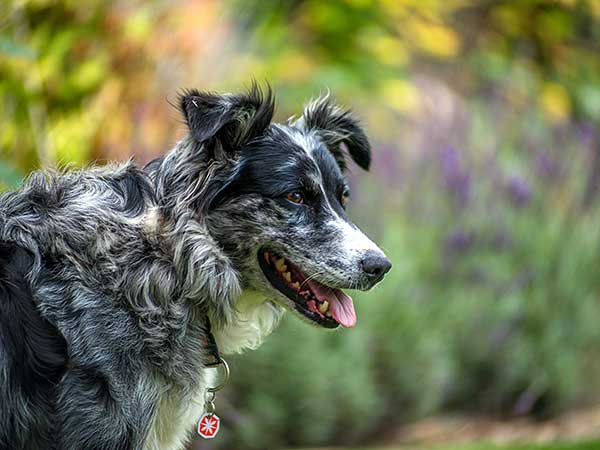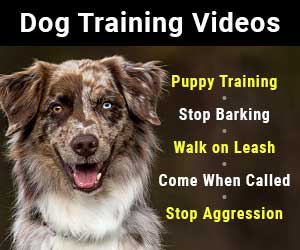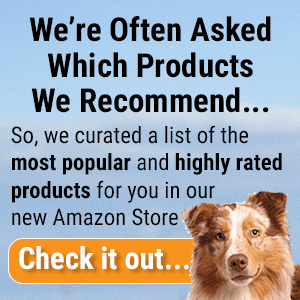
Having Dog Behavior Problems With Your Australian Shepherd?
Most people experience some challenges with dog behavior problems. That's perfectly natural. It stems from asking dogs to live in a human world, and we don't speak each other's languages. The good news is, with some understanding, these issues can be overcome.
To start with be sure that you're being the dog's leader. This does NOT mean being a dictator, being harsh with the dog, doing the 'alpha roll', or not letting your dog go through doorways before you. None of those things are necessary, and in fact, may be harmful. Just be consistent. If you want your dog off the couch, and he doesn't budge, get a treat, call him off the couch, and reward him for getting off the couch. Make listening to you rewarding. But always follow through.
Make sure everyone in the house follows the same rules. Be sure your dog gets enough exercise. A tired dog is an obedient dog. Be sure he has enough mental stimulation. Bored dogs find their own forms of entertainment, and usually it's something we'd rather they didn't do. Training and playing games are good ways to keep your dog's mind busy. Be sure to give your dog plenty of attention. Dogs are social creatures, and aren't meant to live alone. Also, be sure your dog is well socialized. Bring your dog along to the store; take him to dog parks, etc., so he learns how to play with other dogs.

dp268 / stock.adobe.com
With a little patience and consistency you can get dog behavior problems under control.
Destructive Chewing
Dogs chew, that's what they do. But they do this even more so when they're teething, stressed, or bored. First of all, close supervision will help. If your dog is alone for several hours, and chews up the legs of your antique table, he's had hours of reinforcement for the behavior. So, if your dog has this problem, don't leave him unsupervised.
Second, make sure he has toys to chew on. Only let him have stuffed toys while you're supervising him, and don't let him shred them. If you do, he'll learn the joys of ripping things to shreds. What you want are toys like Kongs or Buster Cubes. Used properly, these toys can keep your dog occupied for hours.
When you do catch your dog chewing on something, distract him with a higher value treat. Show him a delicious treat, and lure him away from what he was chewing on. In the future, keep an eye on him, and if he starts to head toward that table leg, call him before he gets there and give him a treat. Pretty soon he'll discover it's more rewarding to be in another area of the room. Make sure he has toys that are more rewarding than the furniture, or whatever it is he's chewing on.
You can also use the 'umbilical cord' technique—keeping your dog attached to you with his leash, so he can never stray out of your site. This helps the dog bond with you, by always being close to you and your activities. But it also prevents him from getting into mischief where you can't see.
Barking
Teach a 'positive interrupt'. In a low distraction environment teach your dog a cue like 'over here', or 'quiet please'. Say the phrase in a cheerful voice, and when your dog looks at you, give him a VERY high value treat! Repeat until your dog lights up when he hears the phrase.
Then start practicing in the low distraction environment. When the dog is busy doing something mildly interesting, try it out. Say it in a cheerful voice, and he should dash to you for his treat. If he doesn't, go back to step one, and try a higher value treat. When he's mastered that, add a minor distraction one at a time, like someone eating potato chips in the same room. Gradually increase the distractions. If your dog ever fails, go back a step. Then move your dog to real life distractions, like his favorite bush on his walk. When you can get this to work in high distraction areas, it's time to try it when he's actually barking!
When something sets your dog off, and you say your cue, he should come running for his treat. Continue to practice this occasionally with milder distractions, as a form of tune up. (Don't use it as an interrupt for barking until you know it works in high distraction areas, otherwise he'll be learning to ignore the cue.)
Mouthing
Use the 'Easy' cue. If he's grabbing a treat from your hand, make a fist. When he stops chewing your hand, open it and let him take the treat. Use a tie down to tie your puppy to a table leg while you play. If he gets too rough, back out of reach for 10-15 seconds, or until he calms down. When he does, start playing again. Use a signal like 'Ouch' or 'All Done' as you back away.
He will quickly learn that Ouch means no more playing, and will start being more gentle. If you're outside playing with the dog and he gets rough, walk away for a few seconds, using the method stated above.
Begging
Don't give in! Don't feed the dog while you're eating. Feed him in his food dish. If you want to give him your pizza crusts, etc., only do it by putting them in his food dish. Also, beware how much and what sort of treats you give him, because you don't want him to have an imbalanced diet or get overweight.
Stool Eating
- Increase playtime with your dog because most need about 30-45 minutes of aerobic activity on a daily basis.
- Increase the number of toys in the house to keep the dog occupied when you are away.
- Keep his exercise areas free of stool because a dog cannot eat what is not there.
- Arrange your dog's feeding times so the play & elimination areas can be cleaned up immediately.
- A basket muzzle may be beneficial to prevent your dog from consuming anything when it cannot be supervised.
- Place a cover over the litter box & limit the dog's access to the cat's toileting area.
- Sometimes, feeding your pet a high protein, low carbohydrate dog food twice a day can help stop this behavior.
- Add a tablespoon of vegetable oil to the dog food everyday may help this situation.
- A teaspoon of meat tenderizer can be mixed into the dog's food as an attempt to stop this behavior. (The lack of digestive enzymes, AMYLASE and/or PAPAIN, may be the problem. Papain is used as an ingredient meat tenderizer.) Prozyme is a ready made product containing these enzymes.
- Add a drop or two of anise, garlic or pumpkin to the dog's food. They apparently give stools a taste which dogs find displeasing.
- When all else fails, there are commercial pet products on the market which can assist in ceasing this behavior. The most notable product is called ForBid. When eaten with the food, the powder makes the dog's feces taste bad. ForBid & other commercial products are available at the veterinary offices or pet stores.
Digging
Again, is your dog bored? Is he staying outside with nothing better to do? Make sure there are toys outside for your dog to play with. Also, when you pooper-scoop, put the feces in the holes your dog dug. For some dogs, a few days of this will convince the dog that digging isn't worthwhile. (The dog won't dig where feces is.)
Another solution is to give the dog an area where he's "allowed" to dig. Make a sandbox type box, and put toys and treats in that area. Reward the dog for being in that area, and if he digs in other areas, continue putting his feces there. The dog will quickly figure out that his sand-box area is the approved digging area.
Jumping Up
- The On-leash Jump with Strangers. Have dog on-leash. Have a friend approach the dog, holding a treat high against the chest. When your dog can't jump on the person, he'll eventually get frustrated and sit down. Have the friend click and treat. Keep repeating. You can also C/T yourself, so the dog learns to look toward you when someone approaches.
- Tie the dog's leash to a fence or other secure object and do the same thing. Approach, and C/T when the dog sits.
- Keep some treats and a clicker by the front door. When you get home and your dog jumps on you, swing away from dog. Every time he jumps, turn away. When he sits, pet him. Be sure to find opportunities to C/T your dog when he sits all on his own. You don't want your dog to learn, 'jump, sit, get a treat'. So by C/Ting when he sits on his own, he won't learn that 'behavior chain'.
You can teach him not to jump on guests by playing a game. Call your dog excitedly to a specified area of the living room (his 'place'). Give him tons of treats for going there. Keep doing that until when you say place, your dog runs there. Then have someone ring the doorbell, and say 'place', and run your dog excitedly to his place. Give him a huge jackpot! By doing this, you can teach the dog to run to his place when the door bell rings. - IF your dog has a strong 'sit' (meaning she sits the moment you tell her to) simply tell her to sit when she approaches. When she sits, praise her and give her a treat. Note: this will only work if she sits the moment you tell her to. If you say 'sit, sit, sit' you're rewarding her for jumping up, by talking to her.
Have Dog Training Questions?
Check out these introductory dog training videos...
I want my dog to stop being aggressive.
I want some help training my new puppy.
I want my dog to stop barking at everything.
Get Australian Shepherd Info, Website Updates, Special Offers, and Cartoons...
FREE GIFT
You'll also receive a free copy of the ebook
My Everyday Dog Training Tools
by professional dog trainer Daniel Abdelnoor, "Doggy Dan"











 Loading Image...
Loading Image...